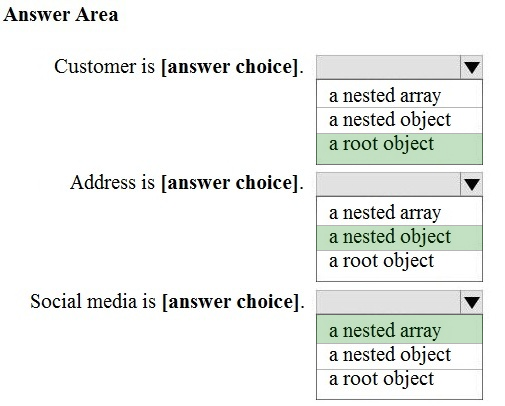DP-900: Microsoft Azure Data Fundamentals
You are reviewing the data model shown in the following exhibit.

Use the drop-down menus to select the answer choice that completes each statement based on the information presented in the graphic.
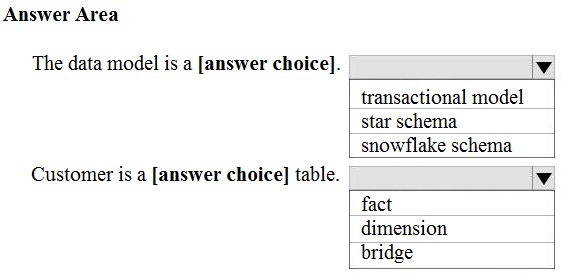
transactional model
star schema
snowflake schema
fact
dimension
bridge
Answer is Star Schema & dimension
Star Schema in data warehouse, in which the center of the star can have one fact table and a number of associated dimension tables. It is known as star schema as its structure resembles a star.

Dimension tables describe business entities—the things you model. Entities can include products, people, places, and concepts including time itself. Fact tables store observations or events, and can be sales orders, stock balances, exchange rates, temperatures, etc. A fact table contains dimension key columns that relate to dimension tables, and numeric measure columns.
Reference:
https://docs.microsoft.com/en-us/azure/synapse-analytics/sql-data-warehouse/sql-data-warehouse-tables-overview
https://en.wikipedia.org/wiki/Star_schema
https://en.wikipedia.org/wiki/Snowflake_schema
https://azure.microsoft.com/en-us/blog/data-models-within-azure-analysis-services-and-power-bi/
To complete the sentence, select the appropriate option in the answer area.

A
B
C
D
Answer is transactional writes
Disadvantages of non-relational databases include: Data Consistency non-relational databases do not perform ACID transactions.
Note: Relational databases are optimized for writes. They are optimized for consistency and availability. Advantages of relational databases include simplicity, ease of data retrieval, data integrity, and flexibility.
Incorrect Answers:
Use a relational database when data that you work with is structured, and the structure is not subject to frequent changes.
Use Cloud storage (no relational database) for geographically distributed writes.
Reference:
https://towardsdatascience.com/choosing-the-right-database-c45cd3a28f77
Your company plans to load data from a customer relationship management (CRM) system to a data warehouse by using an extract, load, and transform (ELT) process. Where does data processing occur for each stage of the ELT process?
To answer, drag the appropriate locations to the correct stages. Each location may be used once, more than once, or not at all. You may need to drag the split bar between panes or scroll to view content.
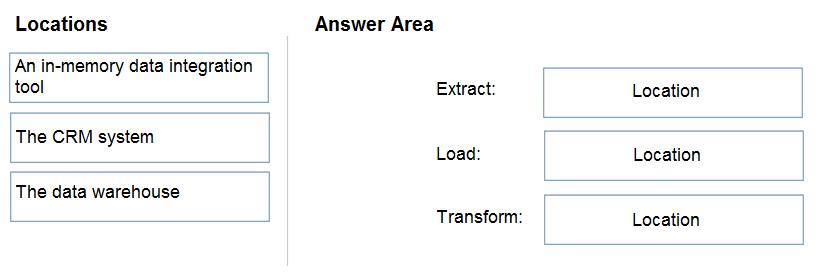
Check the answer section
For ELT, the correct answer is CRM-DWH-DWH
Extract, load, and transform (ELT) differs from ETL solely in where the transformation takes place. In the ELT pipeline, the transformation occurs in the target data store. Instead of using a separate transformation engine, the processing capabilities of the target data store are used to transform data.
Reference:
https://learn.microsoft.com/en-us/azure/architecture/data-guide/relational-data/etl
You need to create an Azure Storage account.
Data in the account must replicate outside the Azure region automatically.
Which two types of replication can you use for the storage account?
zone-redundant storage (ZRS)
read-access geo-redundant storage (RA-GRS)
locally-redundant storage (LRS)
geo-redundant storage (GRS)
read-access geo-redundant storage (RA-GRS): With GRS or GZRS, the data in the secondary region isn't available for read or write access unless there is a failover to the secondary region. For read access to the secondary region, configure your storage account to use read-access geo-redundant storage (RA-GRS) or read-access geo-zone-redundant storage (RA-GZRS).
geo-redundant storage (GRS): Azure Storage offers two options for copying your data to a secondary region:
- Geo-redundant storage (GRS)
- Geo-zone-redundant storage (GZRS)
Careful. If we are talking about "outside replication", the options will be GRS and RA-GRS (particular case that gives active-active between regions with reading accessible in the second one). However, GRS does NOT allow to read in the secondary region in an active-active way. It only happens when the first region fails. Bear this in mind. The option is correct given the requirements in the question.
Reference:
https://docs.microsoft.com/en-us/azure/storage/common/storage-redundancy#redundancy-in-a-secondary-region
You have a SQL query that combines customer data and order data. The query includes calculated columns.
You need to create a database object that would allow other users to rerun the same SQL query.
What should you create?
an index
a view
a scalar function
a table
Answer is a view
A view is a virtual table whose contents are defined by a query. A view acts as a filter on the underlying tables referenced in the view. The query that defines the view can be from one or more tables or from other views in the current or other databases.
Reference:
https://docs.microsoft.com/en-us/sql/relational-databases/views/views
To complete the sentence, select the appropriate option in the answer area.

enforcing constraints
simple lookups
table joins
transactions
Answer is simple lookups
A key/value store associates each data value with a unique key. Most key/value stores only support simple query, insert, and delete operations. To modify a value (either partially or completely), an application must overwrite the existing data for the entire value. In most implementations, reading or writing a single value is an atomic operation.
An application can store arbitrary data as a set of values. Any schema information must be provided by the application. The key/value store simply retrieves or stores the value by key.
Reference:
https://docs.microsoft.com/en-us/azure/architecture/guide/technology-choices/data-store-overview
You have the following JSON document.

Use the drop-down menus to select the answer choice that completes each statement based on the information presented in the JSON document.
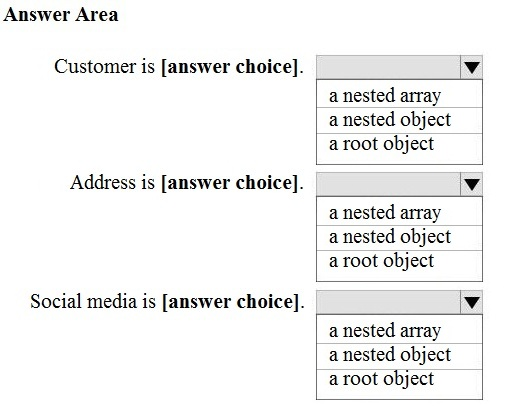
To complete the sentence, select the appropriate option in the answer area.

A clustered index
A File Table
A foreign key
A stored procedure
Answer is A clustered index
Clustered indexes sort and store the data rows in the table or view based on their key values. These are the columns included in the index definition. There can be only one clustered index per table, because the data rows themselves can be stored in only one order.
Reference:
https://docs.microsoft.com/en-us/sql/relational-databases/indexes/clustered-and-nonclustered-indexes-described?view=sql-server-ver15
Match the types of data to the appropriate Azure data services.
To answer, drag the appropriate data type from the column on the left to its service on the right. Each data type may be used once, more than once, or not at all.

Check the answer section
Answer is
1. Image files = Azure Blob storage
2. Relationship between employyes = Azure Cosmos DB Gremlin API
3. Key/value pairs = Azure Table Storage
The Azure Table storage module on MS Learn EXPLICITLY STATES that a weakness of Table storage is its inability to document relationships between rows/entities in the table.
Match the Azure Data Lake Storage Gen2 terms to the appropriate levels in the hierarchy.
To answer, drag the appropriate term from the column on the left to its level on the right. Each term may be used once, more than once, or not at all.
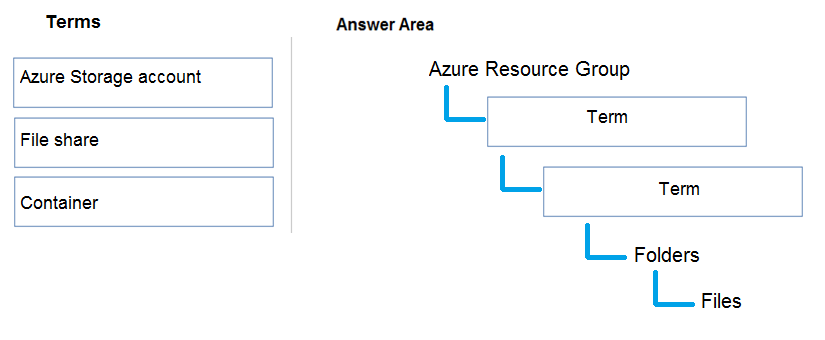
Check the answer section
Answer is Azure storage account and container
Azure Data Lake Storage Gen2 builds on blob storage and optimizes I/O of high-volume data by using a hierarchical namespace that organizes blob data into directories, and stores metadata about each directory and the files within it. This structure allows operations, such as directory renames and deletes, to be performed in a single atomic operation. Flat namespaces, by contrast, require several operations proportionate to the number of objects in the structure. Hierarchical namespaces keep the data organized, which yields better storage and retrieval performance for an analytical use case and lowers the cost of analysis.
Reference:
https://learn.microsoft.com/en-us/training/modules/introduction-to-azure-data-lake-storage/4-azure-data-lake-and-blob-storage
